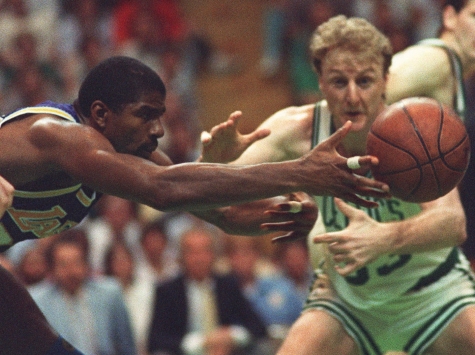Why is the NBA so boring compared to the Eighties, when it was at its zenith with Magic Johnson and Larry Bird, followed by the incomparable Michael Jordan?
There are a number of reasons, but the primary one is this: the players nowadays can’t shoot. They’ve been so conditioned to watching dunks make the highlights on ESPN that their focus is on jumping higher and jamming harder rather than practicing their jump shot. How many times do we have to hear about a player who is a genuine star already going back to the shed and learning how to shoot a basic jumper? (Do the names Lebron James and Rajon Rondo come to mind?)
One of the telling indicators of how much the shooting skills of the average NBA player have diminished is the fact that for the past twenty years, more and more restrictions have been placed on defenders to the point of absurdity. The issue becomes clear when the rules governing the game changed to accommodate the poorer offensive players:
1988-89: Number of referees officiating game increased from two to three. This made players increasingly aware of contact because it was more apparent to the refs.
1990-91: A defender was not permitted to use his forearm to impede the progress of an offensive player who was facing the basket in the front court.
1990-91: The “no-charge area”, where an offensive player could not be called for a foul if making contact with a secondary defender, was expanded.
1999-2000: In the back court, no contact with hands and forearms by defenders. In the front court, no contact with hands and forearms by defenders except below the free throw line extended in which case the defender could only use his forearm. In the post, neither the offensive player nor the defender was allowed to dislodge or displace a player who had legally obtained a position. Defender could not use his forearm, shoulder, hip or hand to reroute or hold-up an offensive player going from point A to point B or one who was attempting to come around a legal screen set by another offensive player.
And, in addition to that: Defenders had to remain on the weak side outside the paint unless they were double-teaming the ball, picking up a free cutter or closely guarding an offensive player. This led to the inability to shut down the opposing team’s star if he didn’t have the ball.
2004-05 • New rules were introduced to curtail hand-checking
All of these changes were made to facilitate scoring, and yet it’s clear that teams still often struggle to score 100 points, which seemed easy in the 1980’s. Could you imagine leaving stars like shooting guards Norm Nixon or Andrew Toney open for a 20-footer? It was automatic. In the famous 1988 mano-a-mano game in the 7th game of the Boston-Atlanta Conference Semifinals when Larry Bird and Dominique Wilkins dueled in the fourth quarter, people forget that in the 118-116 Celtic victory the Celtics shot a whopping 60% from the field and the Hawks 57%. Those are astonishing figures for any game, and that was the deciding game of a semi-final series. And it was because the players could shoot something from more than 8 feet. As unbelievably great as Magic and Bird were in making sure the ball got passed around properly, the other players had to be able to shoot.

COMMENTS
Please let us know if you're having issues with commenting.